Digital Frontier
Header
Main
CG MAKING
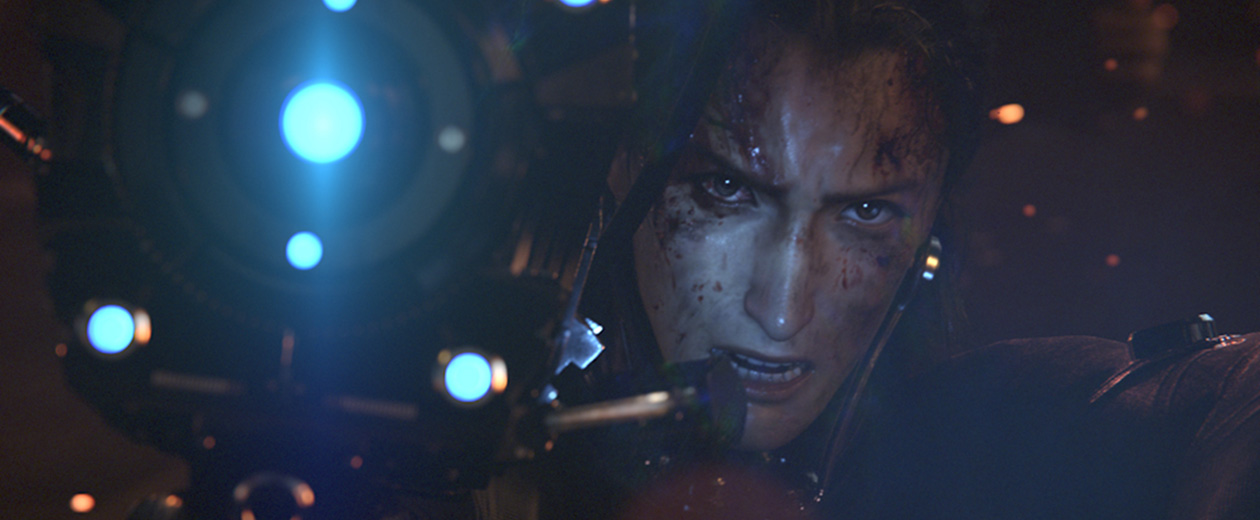
GANTZ:O
October 2016 [CG]
INTRODUCTION
Interview with Yasushi Kawamura
His new challenge for "GANTZ:O"
"GANTZ" was developed from a popular manga into an anime series and live-action films. And now it is going into uncharted territory - a full CG film. Mr. Hiroya Oku the original writer, expects much from the film “GANTZ: O” with its contrast of ordinary and extraordinary life, violence and humor, realism and surrealism, and morality and immorality. These are the challenges needed to be overcome in order to encompass this cool world of GANTZ. This is Mr. Yasushi Kawamura debut as a film director, skipping over being a CG director. Let us discover his passion and tenacity in film.
(Text: Hikaru Kurozumi)
Making full CG film is all about man-hours and simulation within the brain
For the very first full CG film of “GANTZ”, the “Osaka” arc from the middle of the story was selected as it was a very popular event in the original manga.
This is the basic story of “GANTZ”: a person who just died gets revived and then regains consciousness in an unfamiliar room in a condo where there is a black sphere called “GANTZ”. The person then receives a mission along with a special suit and weapons which commits them to fight against monsters that may be aliens. The fight is like a bloody game. Life and death are no longer realistic, the only connection to reality is the pain in their body. This is an extremely modern SF battle action story.
There are special exemption for death and re-birth. And Masaru Kato is the main character in the Osaka arc. He is a childhood friend with the series’ main protagonist Kei Kurono and is also a brother in arms with the GANTZ Tokyo team.
Compared with Kurono who is a typical modern young boy with an introverted and complicated personality, Kato is a traditional hot blooded guy. He lost his parents at an early age and so becomes the parent to his baby brother. He is a compassionate and tearfully sentimental person. Although this contrast of two very different characters has meaning in the story, Director Mr. Yasushi Kawamura of “GANTZ: O” was questioned at first if it was alright to make Kato the main character in the film because he could be too old fashioned.
First major work began with the exploration of the main character Kato
Some fascinating films use an “invisible presence” very cleverly. In “The Third Man”(’49) , a master piece of the golden era of Hollywood, the main character kept searching for Harry Lime who never appears until the end. In “A Letter to Three Wives” (’49), the villainess Addie who made the three wives suffers throughout, never appears on the screen. In “GANTZ: O” as well, Kurono who is an invisible presence, become like a basso continuo, giving the story another dimension.
Another concern in the film “GANTZ: O” for Mr. Kawamura was the graphic depictions. “GANTZ: O” is a work that contains many elements such as SF, Action, Suspense, Mystery, Youth Drama, and Horror. One especially necessary element involved scenes that showed the destruction of the human body. These splatter film like scenes provided a sense of realism and tension to the film.
The problem of how to handle grotesque expressions
Some say “GANTZ” is erotic and grotesque. It might be true if you just looked at the surface, however I thought Mr. Oku illustrated grotesque scenes to express tension and reality. Manga is black and white still images, so drawing excessively grotesque scenes produced tension and fear. Needless to say motion picture has color, sound, and action so I decided not to go for “Here, grotesque scene, yay”. I tried more towards creating high class images with style and a cool atmosphere as well as those in the original work. Comparatively, I would usually make more of an effort in expressing eroticism in the scenes.
The uniqueness of “GANTZ” is that the situations are full of complex rules and details, however not much information is provided to the characters or the audience and we are just shown a mysterious sphere. “GANTZ: O” is the story of Kato going to face his first battle alone. As the story moves along, the audience will be thrown into the survival game with Kato, learning and understanding the rules through one fighting battle scenes after another. This is an excellent way to move the story along however, Mr. Kawamura is concerned that there are too many action scenes.
How to direct an entertaining film
There were so many action scenes going on and on in the film. But just showing action scenes is not good enough, it should contain Kato’s fear in order to step by step, raise the story’s level. Kato is the kind of guy who can keep his heart pure no matter what. So I put elements of game leveling because an essence of the world of GANTZ is that it has these elements: Kato improves how he uses his guns, his movement becomes more sophisticated, he becomes more brave by fighting more. I started to view Kato as getting use to one aspect of battling only to have some incident happen that ratchets up the tension of the story.
I choreographed his actions to be more realistic than being cool. For instance, he would fall when he lands. I had an image of him being similar to a weak Jacky Chan who is running around here and there while getting worse and worse. Action combined with tension and reality, this is what “GANTZ” should exude, I thought.
At first, I thought that if he had a gun than most people would think “Just shoot and finish it”. So I created the X-GUN with settings that included firing range and number of shots. That made the situations look more plausible since he could not shoot right away or maybe he needed to be closer to shoot. I knew that believable context and circumstances is key for SF.
Last year’s “Mad Max: Fury Road” was a great success. The story is quite simple, the main characters runs away from the enemy and comes back, so it took only 5 minutes to tell the synopsis. However, that led to two hours of great action that was beautifully done. If there are unique action concepts with good contrast, the film could be successful. When Mr. Kawamura saw the film “Mad Max: Fury Road” he was convinced that “Just action will be fine.”
Mr. Kawamura is a film lover and is influenced by many action films.
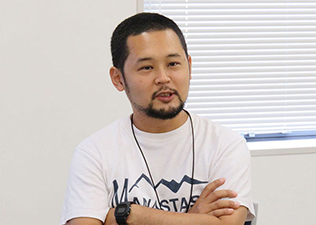 Director, Yasushi Kawamura
Director, Yasushi Kawamura
“GANTZ” had been turned into a TV animation series and a live action film series. Each series has its own uniqueness though. “GANTZ: O” is also a completely new type of challenge in terms of cinematic depiction.
CG animation film which uses deformation character as typified by Disney, Pixar has always been a long existing style within animation. However, full CG film which uses life size character with realistic backdrops similar to a live action film like “GANTZ: O” are still few and are without a specific sub-categorization yet. Our main concern is facial expression.
The problems with character design and the “uncanny valley”
CG contains a lot of information which can be controlled in many ways. Needless to say, motion capture uses realistic movements so the camera work must also be similar to live action films with the background texture being just as realistic as well. Therefore scene development has to be realistic, otherwise those CG can become bumpy. This is called the “uncanny valley” and it can create a feeling of creepiness so it needs to be fixed as much as possible. I include all kind of elements such as texture, movement and camera work “information”, and “adjust deformation reality” side by side in order to try and integrate them together.
With regard to the Uncanny Valley, just explaining away something as being unnatural is not good enough. We need to balance the degree from the texture of the skin being realistic but the movement is stiff to the other end of the spectrum where the skin is unrealistically smooth but the movement is very realistic. These days, we’ve seen androids that have a realistic face but have jerky facial movements. This is quite creepy. The Matsuko-roid is a good example. They emphasized the Uncanny Valley on purpose to make it fun. However, we were terrible at using our own eyes to judge this when we were in the process of creating the characters. So we occasionally had someone objectively view and provide feedback. I always have to keep in mind that it is not about making it as similar to a live action film as possible. With perfect figures, which are different from Disney or Pixar, the key is actually to limit the amount of information.
Mr. Kawamura never made any compromise to the character development and design of the main character Kato’s face. He even worked like an animation director on an animation film.
A CG Director is almost like an animation director?
Even though I can’t draw pictures, I request the files sent to me are in Photoshop and After Effect. For example, I would receive CG of characters’ developmental design from the artists and I would then make changes to the shapes and colors by Photoshop and then send it back. The artists re-make the CG based on my re-touch and send it back to me again. It would be like tossing a ball back and forth. Sometimes I would just show them a picture and ask them to make it like that.
In animation, we have to draw one cut by one cut so that it’s possible for the drawing to go off model. In CG this never happens which is both good and bad because if I say OK unthinkingly or make a compromise, I have to always keep working with that character model. This is why it is important that I keep checking the details. This is the big difference from animation. This process is more like making a model.
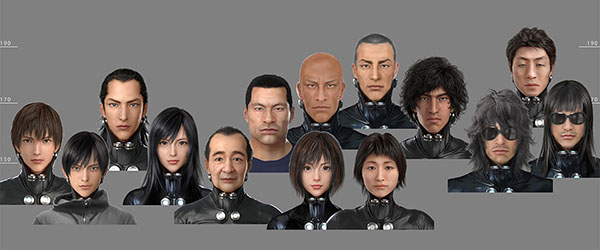 Retouch of main characters
Retouch of main characters
-
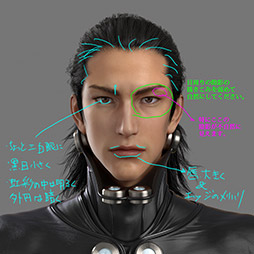 Making the Kato model, comments and specifications in the middle
Making the Kato model, comments and specifications in the middle
-
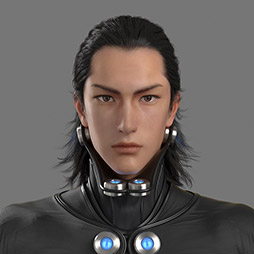 Finished image
Finished image
-
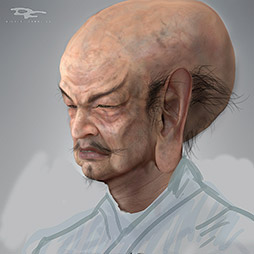 Early stage of Nurarihyon’s image for retouching
Early stage of Nurarihyon’s image for retouching
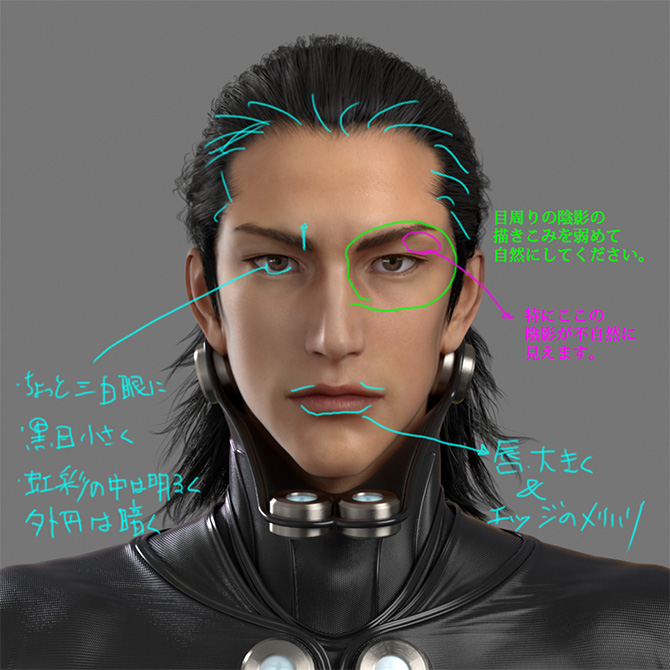 Making the Kato model, comments and specifications in the middle
Making the Kato model, comments and specifications in the middle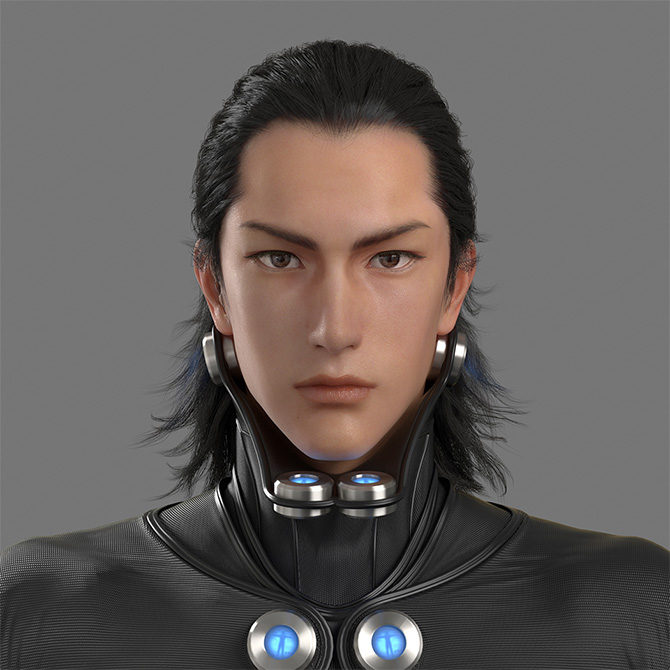 Finished image
Finished image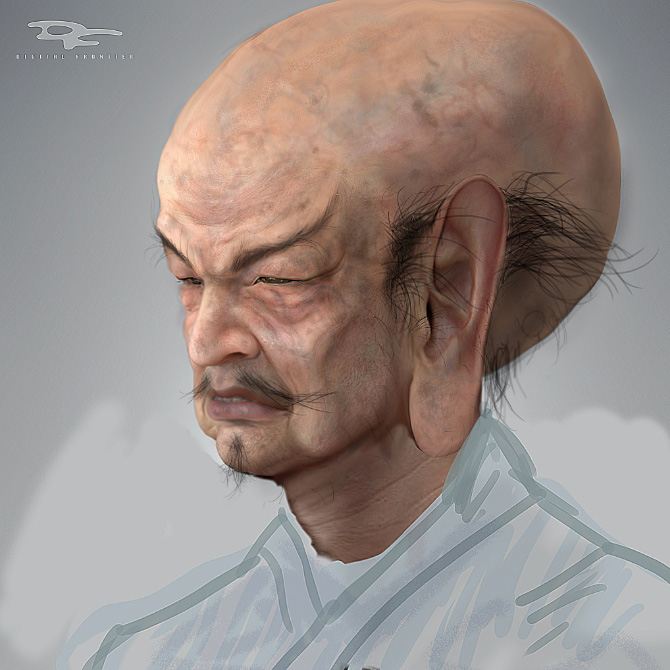 Early stage of Nurarihyon’s image for retouching
Early stage of Nurarihyon’s image for retouching
Generally we often hear things like “CG can do anything so it is not really appreciated”, this is wrong. CG is created by hands with computers. If many people are involved and could spend a great deal of time, then anything is possible, however there is always a limit to the time schedule and budget.
Fighting with man-hours patiently
Another issue was man-hours. We got a remarkable budget for a Japanese film but a tremendous amount of man-hours was needed. During the making of the storyboard, I had to factor in how many times I could return and redo it and developed general idea of how high of a quality I could attain.
In my opinion, a CG director needs to have this ability of continuously updating a current general idea about what and how everything is moving along at the same time. There are a lot of factors other than the animation and there are so many things to build from scratch compared to an actual live film, so that the simulations have to be much more accurate.
 Storyboard
Storyboard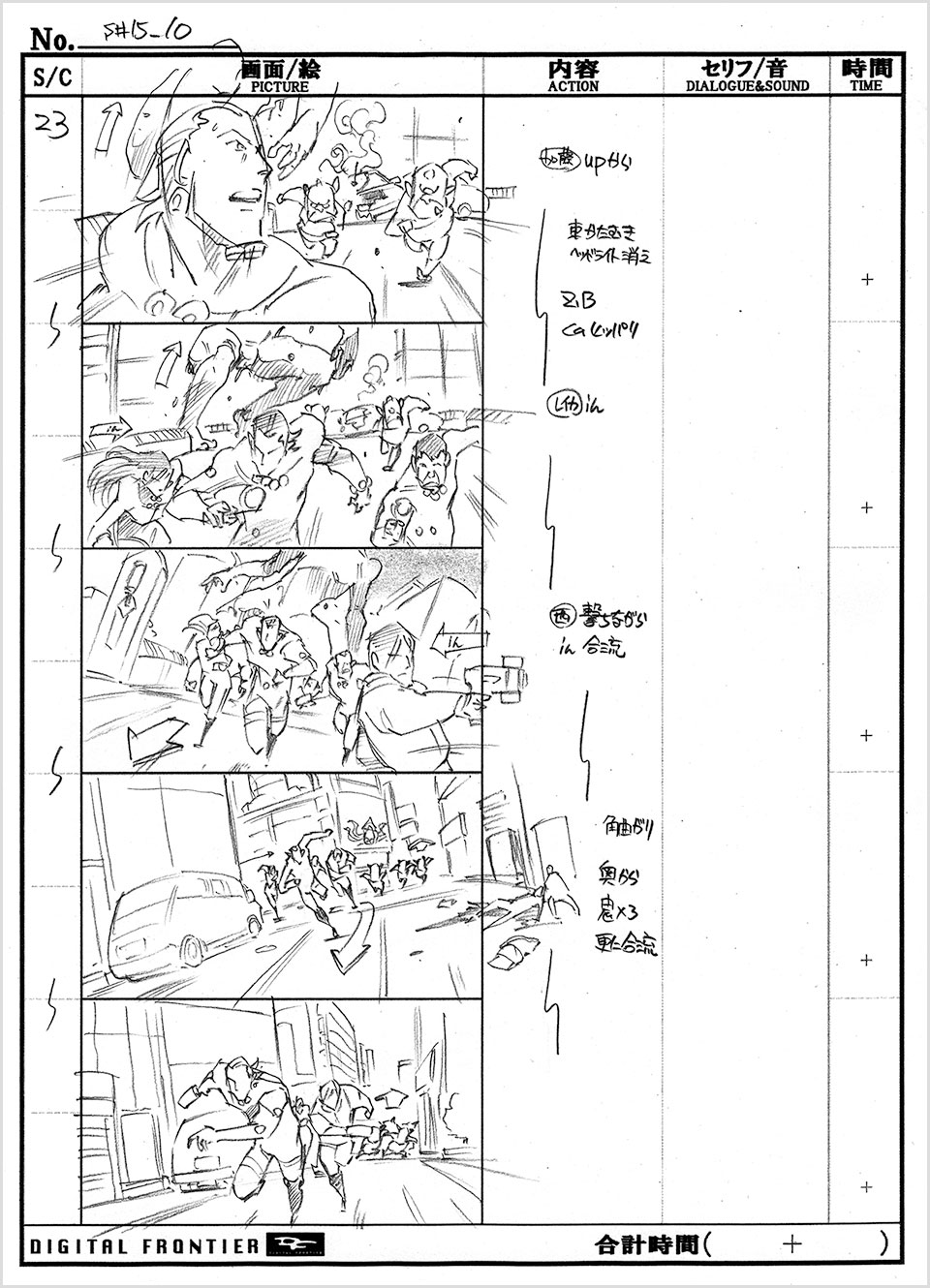
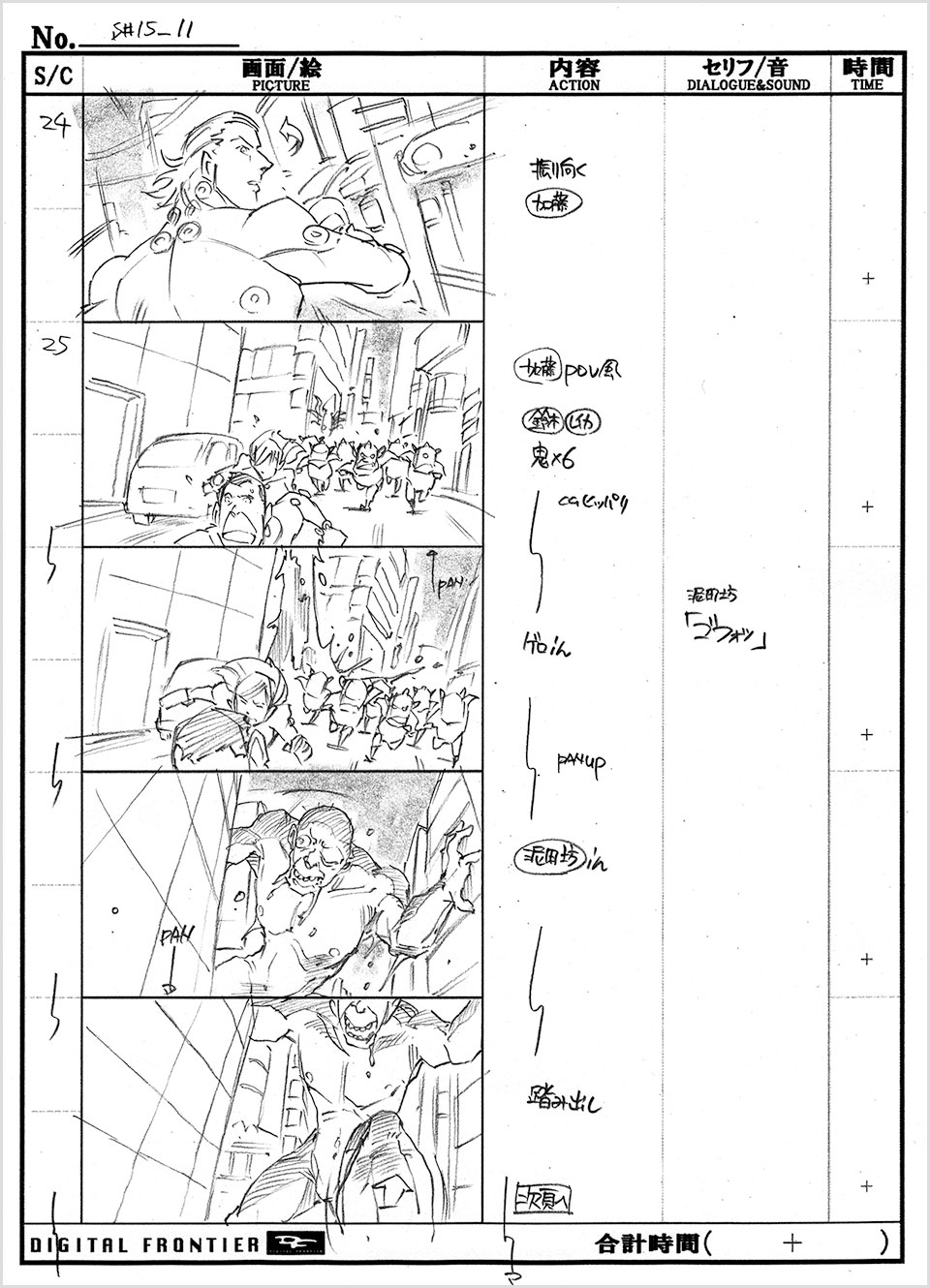
Next, I made a moving storyboard (*) so that I could get a sense of the total length. From my experience, if the moving storyboard only has a little more room than that should be close to the final length. Because when actors actually perform, there are other factors such as the short moments of natural breathing and so on, so the moving storyboard does not account for this. I calculate the man-hours for when the screenplay is up, to checking the storyboard, and if there are some additional effects needed. I would then re-calculate the man-hours and re-check the revised moving storyboard again so that I could increase the precision of the man-hours delegation.
(*) Moving Storyboard: Presenting images from the storyboard in sequence with each image being presented according to its expected duration.
I changed 20% of the camera work based on the moving storyboard with animatics. The reason for why I did this was because realistic camera work with the storyboard showed there was too much to portray. But it inspired me as well. If I made a lot of changes from the original storyboard then production will get upset, so I controlled the man-hours by managing each individual scene in order to save time. I constantly discussed this with team members during the entire process.
After completing the moving storyboard along with a final detailed check of the man-hours allocation, only then could we finally start shooting the motion capture segment. We shot the motion capture segment and the actor’s performance on the set at the same time through three different cameras. We then edited these pictures of movement and I decided on which data to use. We called this entire process "motion capture and film editing" and it allowed us to increase our efficiency dramatically.
I kept thinking that I would make an in-depth plan and would not alter my course like a cheater in paper-rock-scissors. But I did (laugh). I said 100% I would not and then for 10% I would. If I order a redo, man-hours will be spent and the quality would eventually get worse and worse. So I made a lot of editing through software beforehand. As the director, I could test what would and would not work in my mind first, having been prepared to do this through my past experience from editing a lot of scenes. Of course, the film crews have many things to do such as layout, pose, and so on. This allows the director to make the decisions for the other things like length and moments in between and so on. As a result, we can cut down on the man-hours while keeping the quality good. Reconciling the man-hours with the inner critique of your imagined re-creation inside your brain, this duality is the most important thing.
It has been 30 years since the SF film “Tron” (’82) which is the first CG film with the story set in the virtual space of a computer game, was released. Also, it has been 20 years since “Toy Story” (’95) was released. These days we don’t see the boundary between CG and live action film. For instance, in the film “The Revenant”, there was a tremendous struggle to the death between DiCaprio and a bear which is impossible to do in real life so we can guess that that should be CG. Actually there are a lot more CG in live action films than you would have thought but we don’t really notice it. Conversely, CG production uses motion capture segments to get realistic motion information to create films.
In the film “GANTZ: O”, we used Performance Capture (this is the method that takes in every information including face impression, from the actors who performed during the Motion Capture segments) which was only fully developed from the film “Avatar”. Real actors have a large role in CG films these days.
Contributions from the actors to Motion Capture
Mr. Kasahara who played Kato, a high school student, was actually 40 years old. I feel sorry but I had to see him twice during audition because of his age. However, he loves “GANTZ” so much and I certainly think that Kato may look like him when he turns 40. Mr. Kasahara changed his hair style to a slicked back hair style. He showed me his performance many times after which I thought he is the one. And I was right. I could see Kato through him. We captured his facial expressions so it was important that the shape of his face is similar to Kato’s.
Anzu was played by Ms. Katsura, she actually came to audition for the role of Reika. However, at the audition she said “I have a kid like Anzu’s character backstory so I would like to try Anzu as well.” So we gave her a chance and found that she fit it well. These two actors were remarkable.
U’den Flame Works which is a company specializing in action, took part in the action scenes as usual and I collaborated with Mr. Kensuke Sonoda, the action director. I could not draw enough of the action parts for the storyboard, so I wrote down the action composition such as “drop the gun here”, “then fall”, and so on. And Mr. Sonoda would make a video of the stage combat based on my memo. We shot the Motion Capture segments according to the video.
Nyotai-kyojin’s action was played by a small female actor, she was about 150 cm tall. I requested that it should be a mixed of Exorcist and Capoeira and not simple mundane like moves. This was a very impressive sequence with fantastical elements and tension even in the original manga, so I was all fired up and thought it would be worth it if only to show this part to the public. I kept thinking frantically because if I did too much then that would use up man-hours so I was very conscious of this with the mental re-creation in my brain.
The film “GANTZ: O” was accomplished through the tremendous works of many team members and actors. Mr. Kawamura must have received big points from GANTZ for accomplishing this great mission.
Pain and enthusiastic response from the first directed film
I actually dreamed of becoming a film director so I have been studying secretly from ten years ago. However, I was not sure if I could be a film director because I am in the CG industry. The work done on the latter half of this film’s production was similar to CG directing, it was just on a larger scale. However, the first half with the moving storyboard, revising the screenplay, and detailed accounting of man-hours were tough for me both mentally and physically. In making a full CG film, there isn't any manual for the work division nor is there a blue print for the details involved with the CG. There is no one around to do this but me. I spent two month on this and it was the toughest time. Having said that, there was no way I would miss out on this opportunity. There is a very famous anecdote that Director Mr. Hayao Miyazaki drew a storyboard without writing a screenplay. I accidently did something a bit similar and I found that it was unbelievably difficult.
My advantage from being a CG director was that I could calculate man-hours accurately: for instance, how much time we need for hair simulation, what kind of lighting would be difficult, etc. I am sure that it will be difficult to direct a full CG film without any experience from being a CG director.
Since there is no precedent for a full CG film like this, I was very anxious. So I tried to focus on working re-touches, editing pictures for direction, issuing instructions for direction, and so on feverishly to forget my anxiety. I wished I had enjoyed it, however I was stressed since this was my first time directing a film.
Real and Surreal. Hot and Cool. This is the best way to visualize the particular world of GANTZ as a full CG film. Hence a new milestone in this genre was born through GANTZ with its unique material in a full CG film. This meant we could enjoy and get inside a world without wondering if this is a live action film or a CG film. “GANTZ: O” is like a big scroll painting of a night parade of aliens inspired by Ancient Japanese Demons. From Chojyu-giga to Hokusai Manga, Japanese traditional sense of manga and workmanship are strongly alive here. Although he did not aim to exceed the Japanese film industry’s limit or reach to an international level, Mr. Kamimura still achieved this. The best action film that the world has ever seen is born here in Japan.
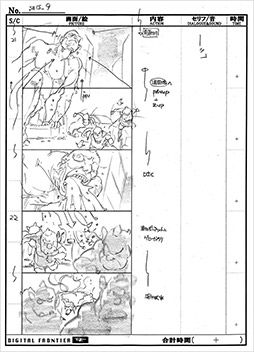
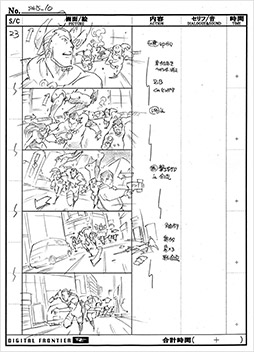
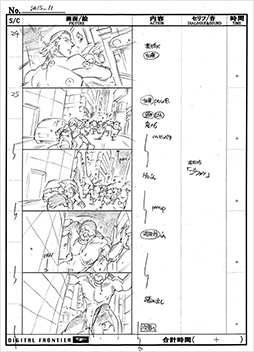
KAWA-
MURA
In the summer of 2011, the producer suggested “Let’s go for the Osaka arc which has not been animated and filmed yet” so I started to make a pilot episode. In the spring of 2012, CG film production went into high gear once we got approval from Mr. Oku. I only met him three times. The first meeting was two years ago in the summer I remembered. He shook my hands and said “Please go for it.” I was nervous though I was so glad that I could finally meet him and felt his excitement for our pilot episode through his powerful hands shake. That moment always supported me through the hard times during the making of the film.
Developing the screenplay was tough at the beginning. The main character Kato is a foil to Kurono in the original manga and was too good of a man. I need to add something so that he didn’t look like an old fashion hero. The original manga contained twenty volumes of books, so a lot of history has already happened. If we had made a film about the Osaka arc on its own, the audience may not feel any sense of emotional attachment because it could be seen to be a story about a good young boy just doing good things. I was concerned about this at first.
So, I read the original manga again and again and I found that I could explore Kato’s fear and his anti-fighting feeling. I created a back story showing that he had a strong sense of justice because he was somewhat obsessive compulsive inside. There is a phrase “Social Justice Warrior (SJW)” that means “a person who fights against discrimination on the internet” which ended up having a negative connotation like “a person who judges others from a safe place about social justice.” Kato is “I will help people at any time, even if there are risks” type of guy so he is the opposite of a SJW. So I thought this idea would be a good theme about society that I could go more in depth in the film. I aimed towards making a simple and powerful entertainment film precisely because I wanted to have a primal theme behind it. I remembered finally feeling “This could be great” at that moment.
Before I became the film director, the screenplay had already been mostly completed. However, I really wanted to make some changes so I revised them after I started working as the director. One of them was in Kurono’s dialogue: “Do it, we have no other way.” Although there was no such dialogue in the original screenplay this catch phrase is like the pillar of the story, it connected Kurono’s will to Kato’s will.